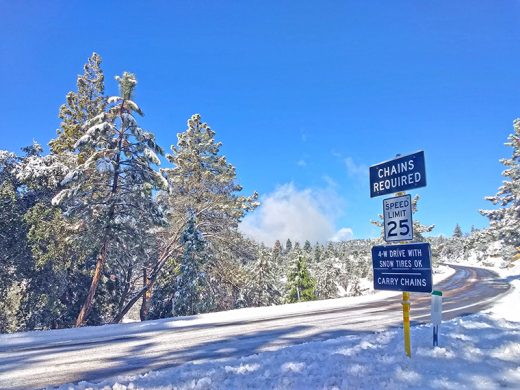
Living in the mountains can pose many challenges when it comes to being safe on the roads during winter. It comes with the territory of living in mile-high Idyllwild and surrounding communities, where we get to experience what many in Southern Californians don’t — four seasons. With the first snow of the season already in the books, it’s time to be prepared while traveling on the roadways.
The Town Crier spoke with the California Highway Patrol (CHP) about what tire traction devices, commonly referred to as chains, are approved during inclement weather conditions. CHP Officer Matt Napier stated, “Section 605 of the California Vehicle Code defines tire traction devices as ‘devices or mechanisms having a composition and design capable of improving vehicle traction, braking, and cornering ability upon snow or ice-covered surfaces.’ It also states that tire traction devices need to be constructed to ‘provide sufficient structural integrity and to prevent accidental detachment from vehicles.’”
According to the United States Patent and Trademark Office website, “Grip Tread for Pneumatic Tires” was patented on Aug. 23, 1904 by Harry D. Weed of Canastota, New York. Since then, many variations of chains, cables and newer inventions, like snow socks, have been built for different size tires and vehicles.
With that, there are no official CHP-approved tire traction devices. According to Napier, it is strictly up to the individual officer’s discretion on whether a tire traction device meets the definition of the vehicle code. Whatever traction device you choose for your vehicle, be sure it is within the guidelines so you don’t get cited, or even worse, cause injury to yourself or someone else.
Caltrans set three different levels when tire traction devices are required during inclement weather. Caltrans can choose to implement any of these levels at any time, so make sure tire traction devices (chains, cables, snow socks, etc.) are in your vehicle at all times.
The lowest level, R-1, states that “chains are required on all vehicles except passenger vehicles and light-duty trucks under 6,000 pounds gross weight and equipped with snow tires on at least two drive wheels,” according to the Caltrans website. “Chains must be carried by vehicles using snow tires. All vehicles towing trailers must have chains on one drive axle. Trailers with brakes must have chains on at least one axle.”
The next level, and most common for our highways, is R-2. This states that chains are required on all vehicles except four-wheel-drive or all-wheel drive vehicles with snow tires on all four wheels.
In the worst-case scenario, R-3 requires a tire traction device on all vehicles including those with all-wheel or four-wheel-drive.
In most cases, roads are closed before R-3 is put into place due to safety concerns, according to Napier.
For all requirement levels — R1 through R3 — a tire traction device is required to be carried in all vehicles. No exceptions.
Road conditions and requirements can be determined by the signage on the roadway. Drive safely and be prepared this winter.










